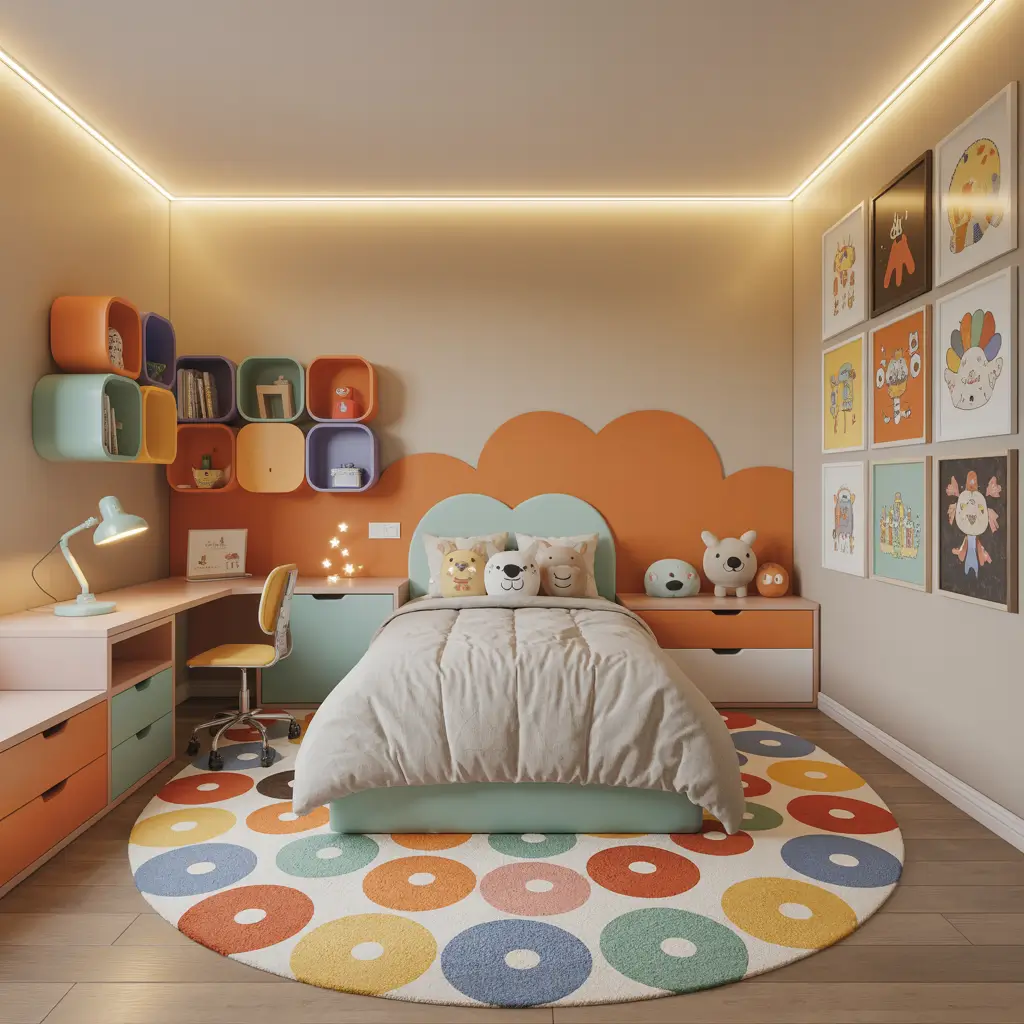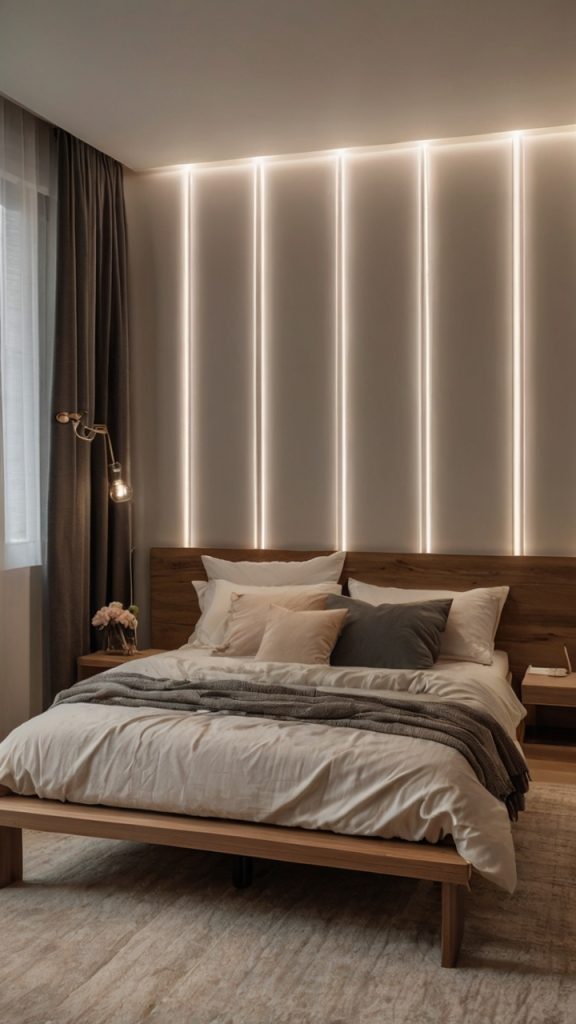15 Amazing Small Kids Bedroom Ideas for Cozy Spaces
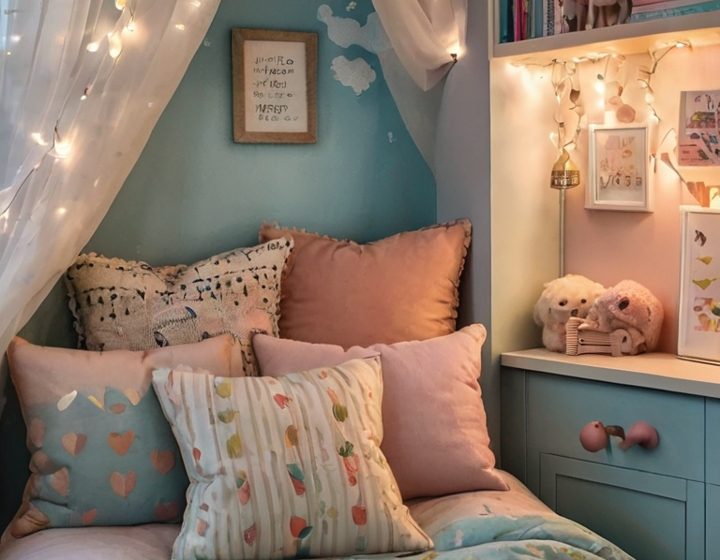
Let me guess – you’re staring at your kid’s tiny bedroom wondering how on earth you’ll fit a bed, toys, clothes, AND still leave room for them to actually play? Yeah, I’ve been there. My daughter’s room is basically the size of a glorified closet, and I swear those toys multiply overnight like gremlins.
But here’s the thing: small bedrooms can actually be amazing when you know the right tricks. I’ve spent the last three years experimenting with every space-saving hack imaginable (and trust me, some were total disasters).
Today I’m sharing the 15 ideas that actually work – the ones that’ll transform that shoebox into a space your kid genuinely loves.
Loft Bed with Under-Desk Study Area
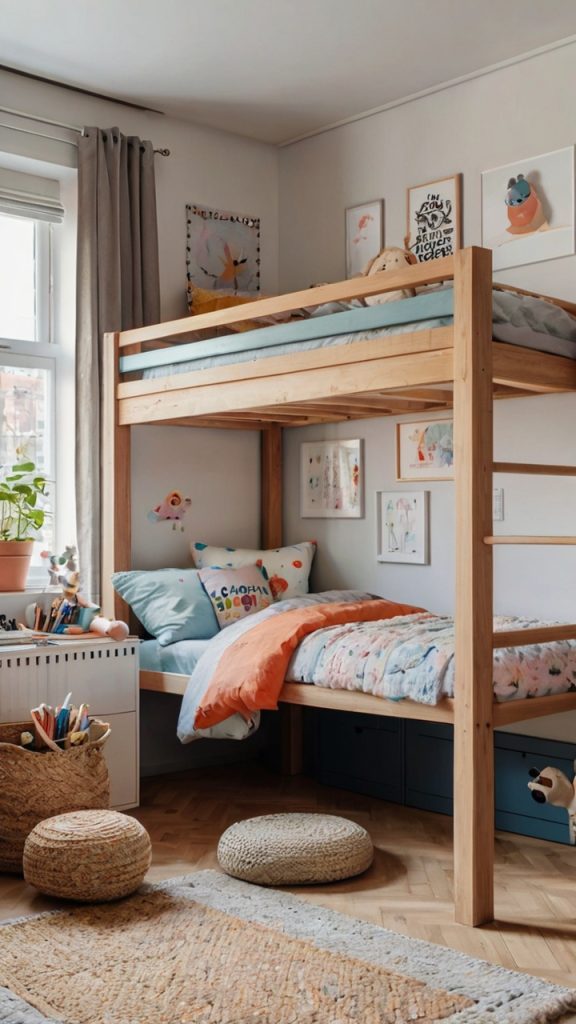
This one’s a game-changer, folks. Remember how cool you thought bunk beds were as a kid? Well, loft beds are like bunk beds’ cooler older sibling – minus the sibling fights over who gets the top bunk.
I installed one of these beauties in my son’s room last year, and suddenly we had double the floor space. The genius part? That area underneath becomes a perfect study zone. We tucked a small desk under there with some LED strip lights, and boom – instant homework headquarters.
Making It Work in Your Space
The key measurements you need to know:
- Ceiling height: You need at least 8 feet for comfort
- Bed height: Aim for 5-6 feet off the ground
- Desk clearance: Leave 30-32 inches for leg room
What really sold me on this setup was watching my kid actually USE the desk. Before, homework happened on the bed (spoiler alert: that never ended well). Now he has his own little cave underneath where he can focus. Plus, climbing up to bed every night? Kids think that’s the coolest thing ever.
Floating Shelves and Wall Storage
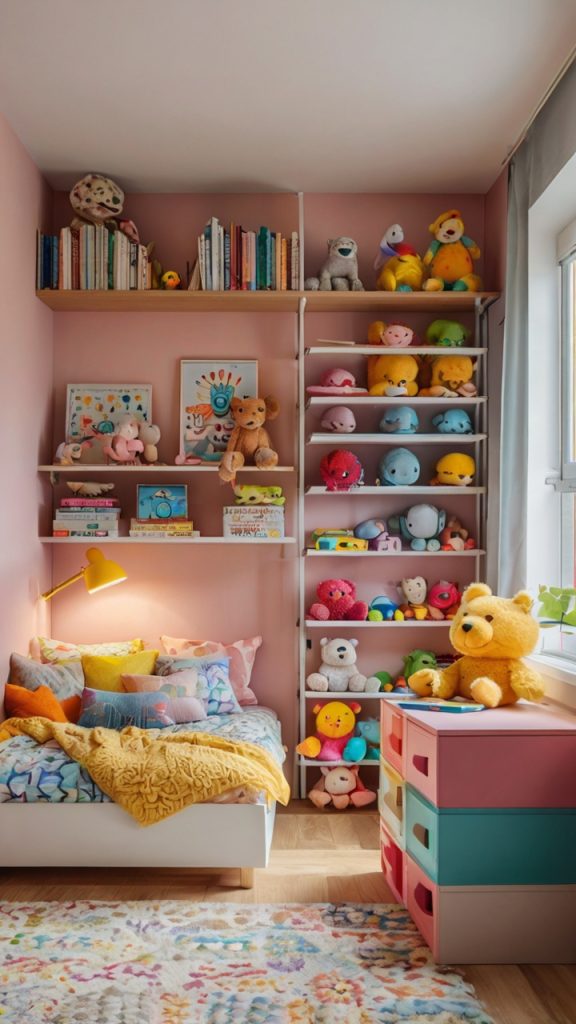
Walls are your best friend in a small room – seriously, they’re like free real estate nobody’s using. I learned this the hard way after tripping over toy bins for months.
Floating shelves changed everything. They look clean, take up zero floor space, and you can arrange them however you want. I put three long ones above my daughter’s dresser, and suddenly all those random knick-knacks had a home.
Strategic Placement Tips
Here’s what works best:
- Install shelves at kid height for everyday items
- Put seasonal stuff up high
- Use corner shelves for dead space
- Mix shelf lengths for visual interest
The trick is not going overboard. You want storage, not a wall that looks like a library exploded. I stick to the rule of three – three shelves per wall max, unless you’re going for a full gallery wall effect.
Minimalist Monochrome Room Design
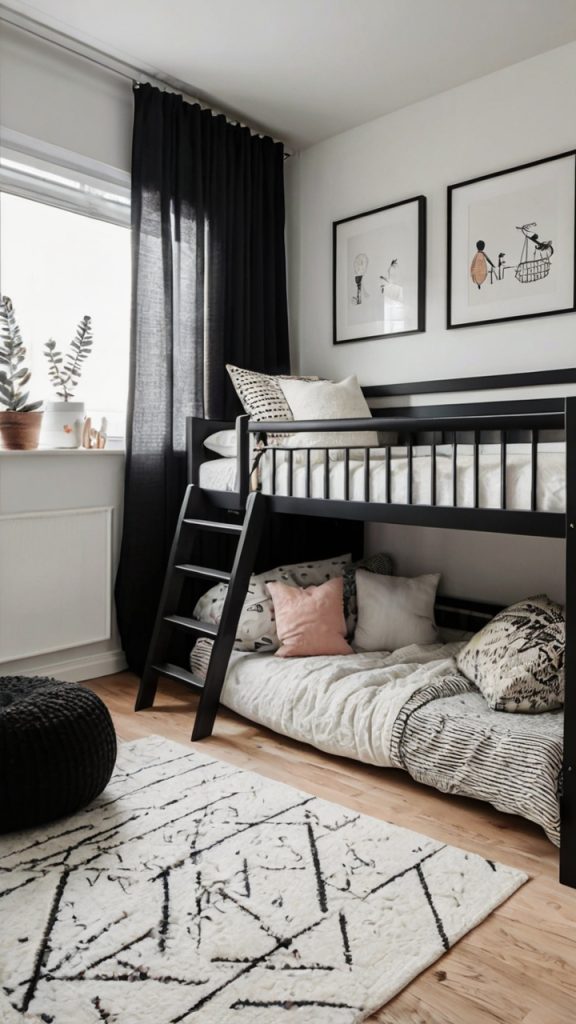
Okay, hear me out on this one. I know “minimalist” and “kids” seem like they don’t belong in the same sentence. But a monochrome color scheme actually makes tiny rooms feel way bigger.
We went with grey and white in my nephew’s room (with his input, obviously – he picked “storm cloud grey” which sounds way cooler than just grey). The result? The room looks twice as big and surprisingly, stays cleaner-looking even when toys are out.
Why This Works for Kids
The benefits nobody tells you about:
- Less visual chaos = calmer bedtime
- Everything matches automatically
- Hand-me-downs blend in easier
- Kids’ colorful toys become the art
You don’t have to go full black-and-white prison cell vibe either. Pick a base neutral and add ONE accent color through bedding or art. Trust me, your eyes (and sanity) will thank you.
Also Read: 15 Cozy Small Guest Bedroom Ideas for Stylish Space
Bunk Beds for Sibling Sharing
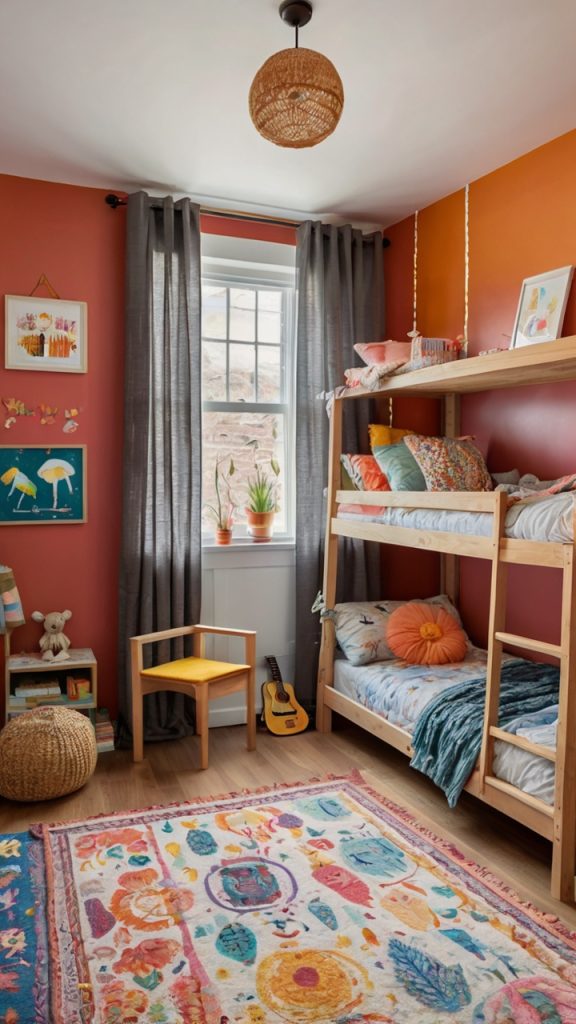
Sharing a small room with a sibling? That’s like expert-level parenting right there. Bunk beds are basically non-negotiable in this scenario, unless you want beds taking up 80% of the floor.
I’ve been through three different bunk bed setups (long story), and here’s what actually matters: sturdiness and storage. Skip the cheap metal frames – they’re noisy and wobbly. Go for solid wood if your budget allows.
The Sibling Peace Treaty Setup
Smart additions that prevent World War III:
- Individual reading lights for each bunk
- Separate storage cubbies built into the frame
- Privacy curtains (game-changer for older kids)
- Different colored bedding for personalization
The L-shaped bunks are brilliant if your room layout allows it. Each kid gets their own corner, which somehow reduces the “they’re looking at me!” complaints by like 75%.
Pastel-Themed Cozy Corner
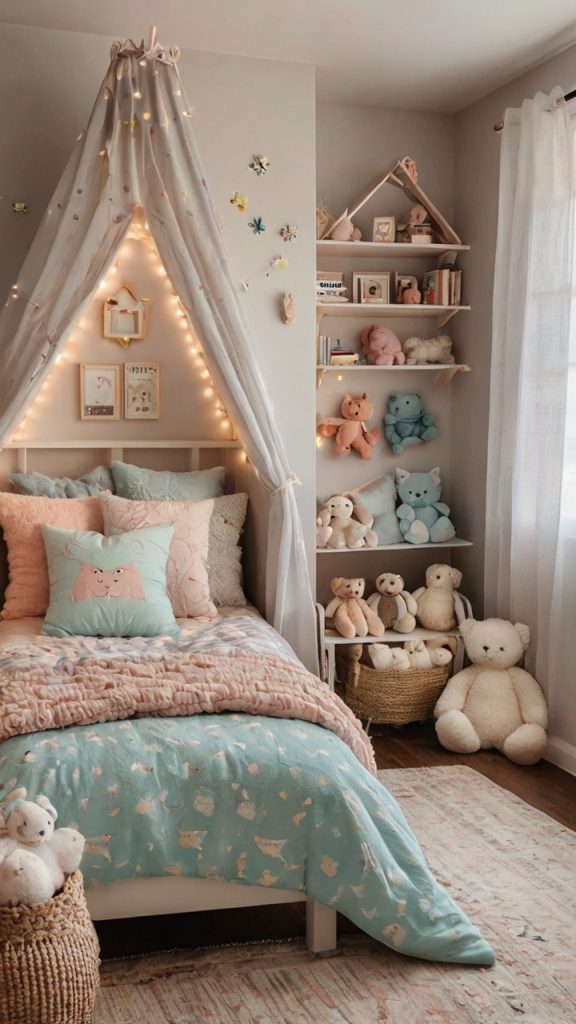
Who says small has to mean boring? A pastel color palette creates this soft, dreamy vibe that makes tiny spaces feel like cozy hideaways instead of cramped boxes.
My friend did her daughter’s room in soft pinks, mint greens, and buttery yellows. The effect is like stepping into a macaron shop – sweet without being sickly. The light colors bounce natural light around, making the room feel airy even though it’s only 8×10 feet.
Creating the Vibe Without Breaking the Bank
Budget-friendly pastel touches:
- Paint just one accent wall
- Use removable wallpaper panels
- Add pastel storage bins
- Switch out lampshades and curtains
The secret sauce? Keep the base neutral (white walls, natural wood furniture) and add pastel through accessories. That way, when your kid decides they hate pink next year, you’re not repainting the entire room.
Playful Wall Murals and Decals

Wall decals are basically the lazy parent’s dream solution (and I mean that in the best way). No painting skills required, completely removable, and kids LOVE them.
We started with a simple tree decal in the corner, then added birds, clouds, and before I knew it, we had a whole forest scene. The room suddenly had personality without taking up any actual space.
Decal Do’s and Don’ts
What I learned the hard way:
- Do let kids help choose and place them
- Don’t go crazy – less is more in small spaces
- Do create scenes that grow with themes
- Don’t put them where furniture might go later
FYI, the peel-and-stick wallpaper murals are incredible these days. We did a mountain range behind my son’s bed, and visitors always think we hired an artist.
Also Read: 15 Stunning Living Room Curtains Ideas Modern Ideas for Every
Compact Storage Bed with Drawers
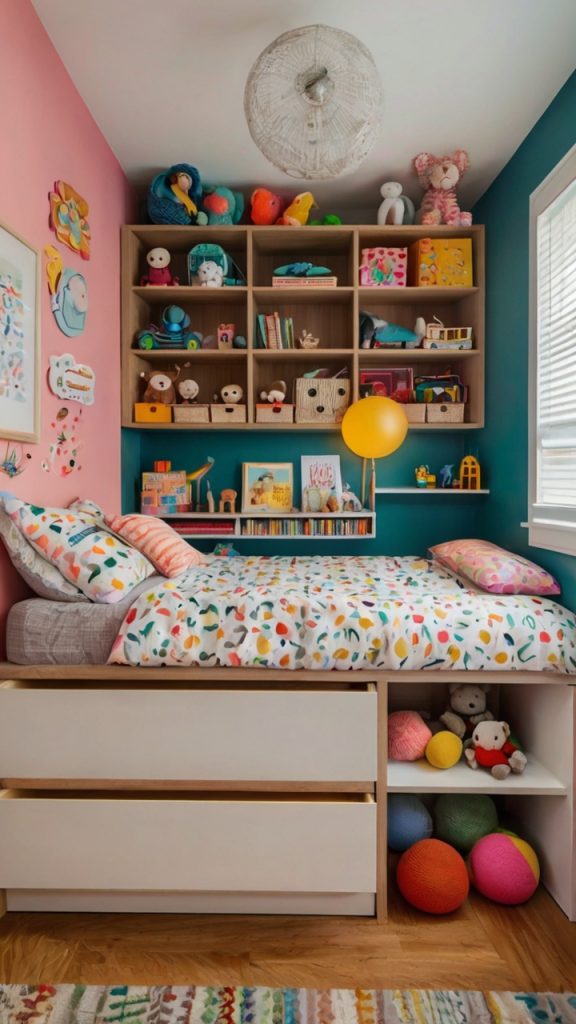
Can we talk about how beds with built-in storage are basically wizardry? You’re sleeping on top of a dresser. It’s genius.
I was skeptical at first – wouldn’t the drawers be annoying to access? Turns out, nope. My kids actually find it easier than a regular dresser because they can sit on the floor and pull everything out (which they do anyway, let’s be real).
Maximizing the Storage Potential
Organization hacks that work:
- Use drawer dividers for small items
- Seasonal rotation – winter clothes in back drawers
- Label drawers with pictures for non-readers
- Keep frequently used items in side drawers
The captain’s bed style with drawers on both sides gives you maximum storage. Just make sure you can still walk around the bed – learned that one the hard way.
Convertible Furniture for Growing Kids

Kids grow fast (like, scary fast). That toddler bed that seemed huge? Yeah, it’ll be tiny in approximately five minutes. Convertible furniture saves you from buying new stuff every two years.
We got a crib that converts to a toddler bed, then a full bed. Six years later, still using the same piece. The desk in my daughter’s room? Adjustable height legs. Even our storage unit transforms from toy chest to bookshelf configuration.
Smart Convertible Investments
Pieces worth spending on:
- Adjustable-height desks that grow with them
- Modular shelving systems
- Expandable closet organizers
- Convertible bed frames
The upfront cost seems high, but do the math. Buying quality convertible furniture once beats buying cheap furniture three times. Plus, less furniture shopping means more time for… literally anything else.
Hanging Toy Organizers and Baskets
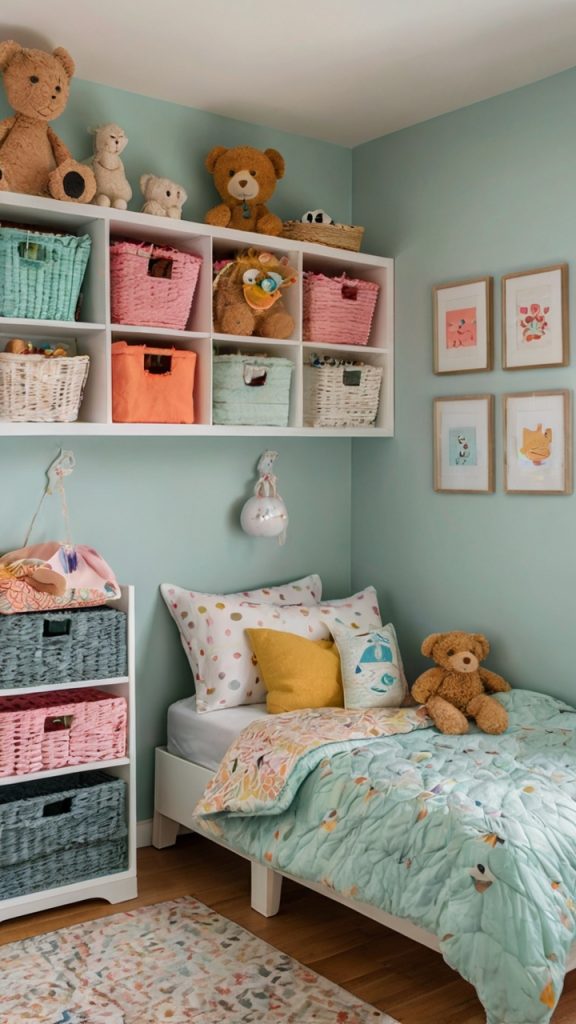
Vertical storage isn’t just for walls – hanging organizers use that precious vertical space without permanent installation.
Those mesh hanging towers? Total game-changer for stuffed animals. We have one in the corner that holds approximately 47,000 stuffies (slight exaggeration, but barely). The best part: kids can actually see and reach their toys, so they might actually play with them instead of dumping everything out.
Creative Hanging Solutions
Beyond basic organizers:
- Macrame hammocks for lightweight toys
- Ceiling-mounted nets for balls and sports gear
- Over-door shoe organizers for art supplies
- Hanging buckets on wall hooks
Pro tip: hang organizers at different heights. Lower ones for everyday favorites, higher for rotate-in toys. It’s like having a toy library system 🙂
Also Read: 15 Stunning Blue Curtains Living Room Ideas for Cozy Spaces
Space-Saving Foldable Desk Setup
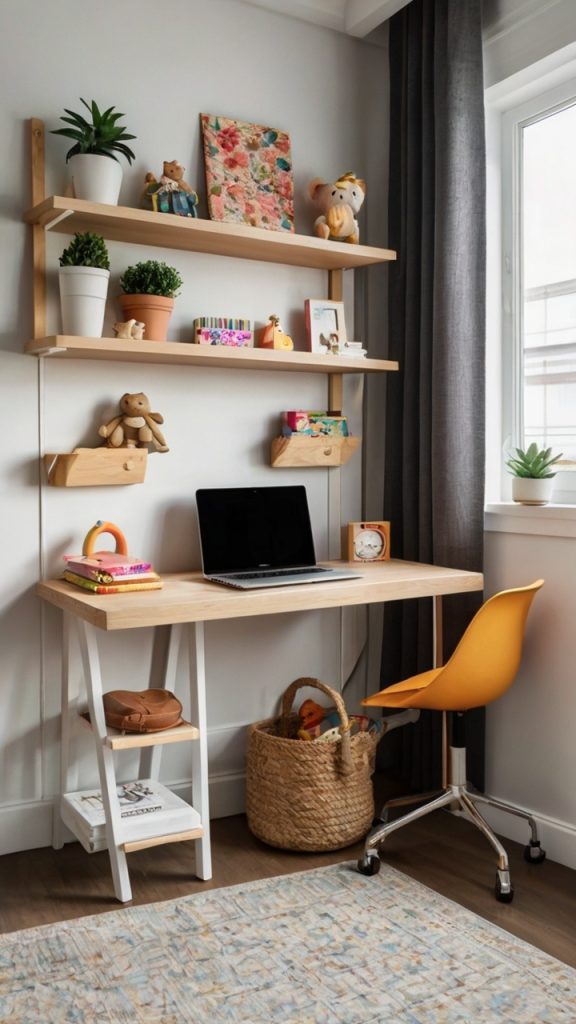
Not every kid needs a permanent desk taking up precious floor space. Enter the fold-down desk – there when you need it, gone when you don’t.
We installed a wall-mounted drop-leaf desk in my son’s room, and honestly, it’s brilliant. Homework time? Flip it down. Play time? Flip it up. The wall space above becomes a perfect spot for a bulletin board or shelving.
Making Foldable Work Long-term
Key features to look for:
- Sturdy wall mounting (this isn’t optional)
- Built-in storage compartments
- Cable management for devices
- Smooth folding mechanism kids can handle
Some models have a small shelf that stays out even when folded. Perfect for keeping pencils and supplies handy without the full desk footprint.
DIY Creative Reading Nook
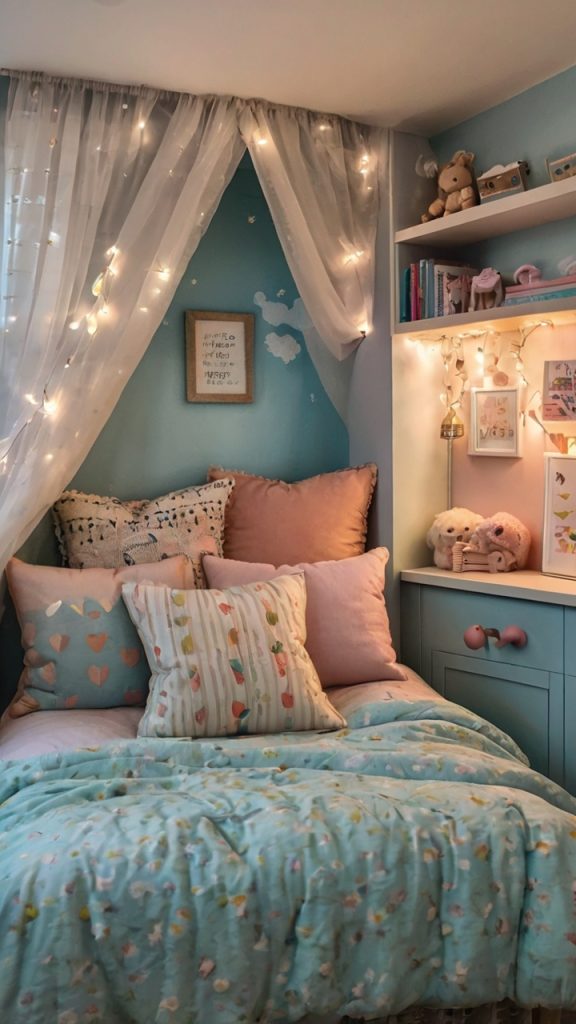
Every kid needs a cozy spot to escape into books, even in the tiniest room. A reading nook doesn’t need much space – just creativity.
We transformed the corner behind my daughter’s door (dead space anyway) into a reading paradise. Hung a canopy from the ceiling, threw down some floor cushions, added string lights, and suddenly she had her own magical hideaway.
Building Your Own Book Haven
Essential elements for the perfect nook:
- Soft seating (bean bags, floor pillows, or a small chair)
- Good lighting (battery-operated if no outlet nearby)
- Book display (floating shelves or book slings)
- Cozy textiles (canopy, curtains, or tapestry)
The beauty of a DIY nook? You can literally squeeze one anywhere. Behind the door, in a closet with doors removed, even under a loft bed. My neighbor made one in a large closet – removed the doors, and it became the favorite spot in the house.
Nature-Inspired Green Accent Room

Bringing nature indoors makes small spaces feel fresh and alive. A green accent room doesn’t mean painting everything forest green (though you could). It’s about creating a natural, calming environment.
We added plants (fake ones, because let’s be honest about our plant-parenting skills), wood elements, and nature-themed art. The room feels like a treehouse now, minus the actual tree.
Green Room Elements That Work
Natural touches to consider:
- Bamboo or rattan storage baskets
- Leaf-patterned bedding or curtains
- Wood accent wall (or peel-and-stick wood panels)
- Botanical prints or photography
Real plants that survive kid rooms: pothos, spider plants, and succulents on high shelves. Skip anything poisonous or delicate – learned that lesson when my toddler decided the fern needed a haircut.
Modular Cubes and Stackable Storage
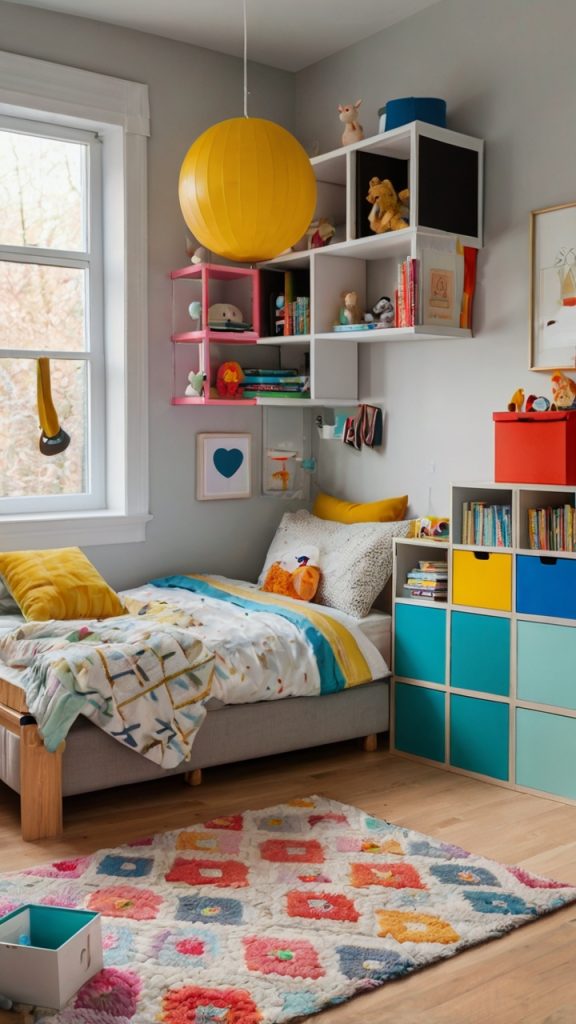
Modular storage cubes are like adult LEGOs – you can configure them however you want. Need more vertical storage? Stack ’em up. Want a bench? Line them horizontally.
We have a 3×3 cube system that’s been rearranged about fifteen times. Currently, it’s part bookshelf, part toy storage, part display case for my kid’s rock collection (don’t ask).
Cube Configuration Magic
Smart ways to use cube storage:
- Create room dividers in shared spaces
- Use fabric bins for hiding clutter
- Leave some cubes empty for display
- Add cushions on top for extra seating
The beauty of modular systems? When you move or kids’ needs change, you just reconfigure instead of buying new furniture. IMO, that’s just smart parenting economics.
Under-Bed Pull-Out Play Area

This idea blew my mind when I first saw it. A trundle-style play surface that slides under the bed? Genius for tiny rooms.
Instead of a second mattress, some trundle frames can hold a play table, train set, or dollhouse setup. When playtime’s over, it slides away completely. My friend did this with her son’s LEGO table, and it’s prevented approximately one million foot injuries.
Creating the Ultimate Hidden Play Space
Options for under-bed play areas:
- Rolling platforms for building sets
- Art supply stations on wheels
- Dress-up clothes on a rolling rack
- Pull-out desk for older kids
Make sure whatever system you choose has smooth-rolling wheels or slides. Nothing kills the magic faster than having to wrestle the thing in and out.
Bright Color Pops in Neutral Room
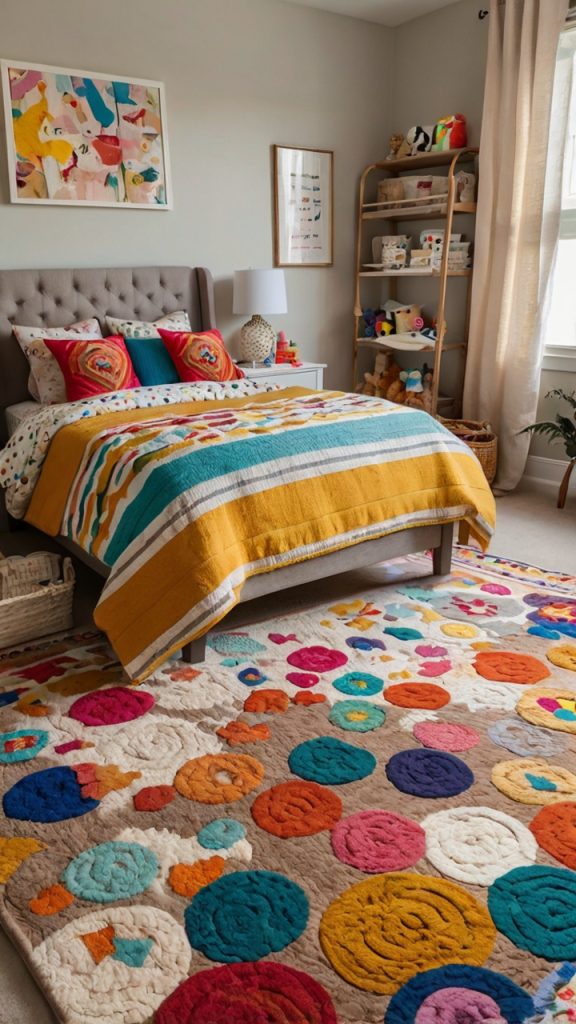
Here’s the thing about all-neutral rooms – they can feel a bit… bland for kids. But going full rainbow can make small spaces feel chaotic. The sweet spot? Strategic pops of bright color against neutral backgrounds.
We kept my daughter’s walls white but added hot pink curtains, a turquoise rug, and yellow throw pillows. The room feels energetic and fun without being overwhelming. Plus, swapping accent colors as kids grow is way easier than repainting.
Color Pop Strategy
Where to add your bright moments:
- Bedding (easiest to change)
- Artwork and posters
- Storage bins and organizers
- One statement furniture piece
The 80/20 rule works great here – 80% neutral, 20% color. Enough personality to make kids happy, enough calm to keep parents sane.
Making It All Work Together
Look, transforming a small kids’ bedroom isn’t about following every trend or buying expensive furniture. It’s about finding what works for YOUR kid and YOUR space.
Maybe you’ll mix and match these ideas, or maybe one solution solves all your problems. The point is, small bedrooms don’t have to feel limiting. With some creativity and smart planning, they can be just as functional and fun as any McMansion playroom.
The best part about all these ideas? Most of them grow with your kids. That reading nook becomes a homework spot. The loft bed transitions to teen hangout space. The modular storage adapts to changing interests.
Remember, kids don’t see small bedrooms as limitations – they see cozy hideaways and adventure spaces. Sometimes we just need to borrow their perspective and add a little practical magic to make it all work. Who knows? You might end up with a room so cool, you’ll wish it was yours. (I definitely don’t hide in my kid’s reading nook sometimes. Definitely not.)
